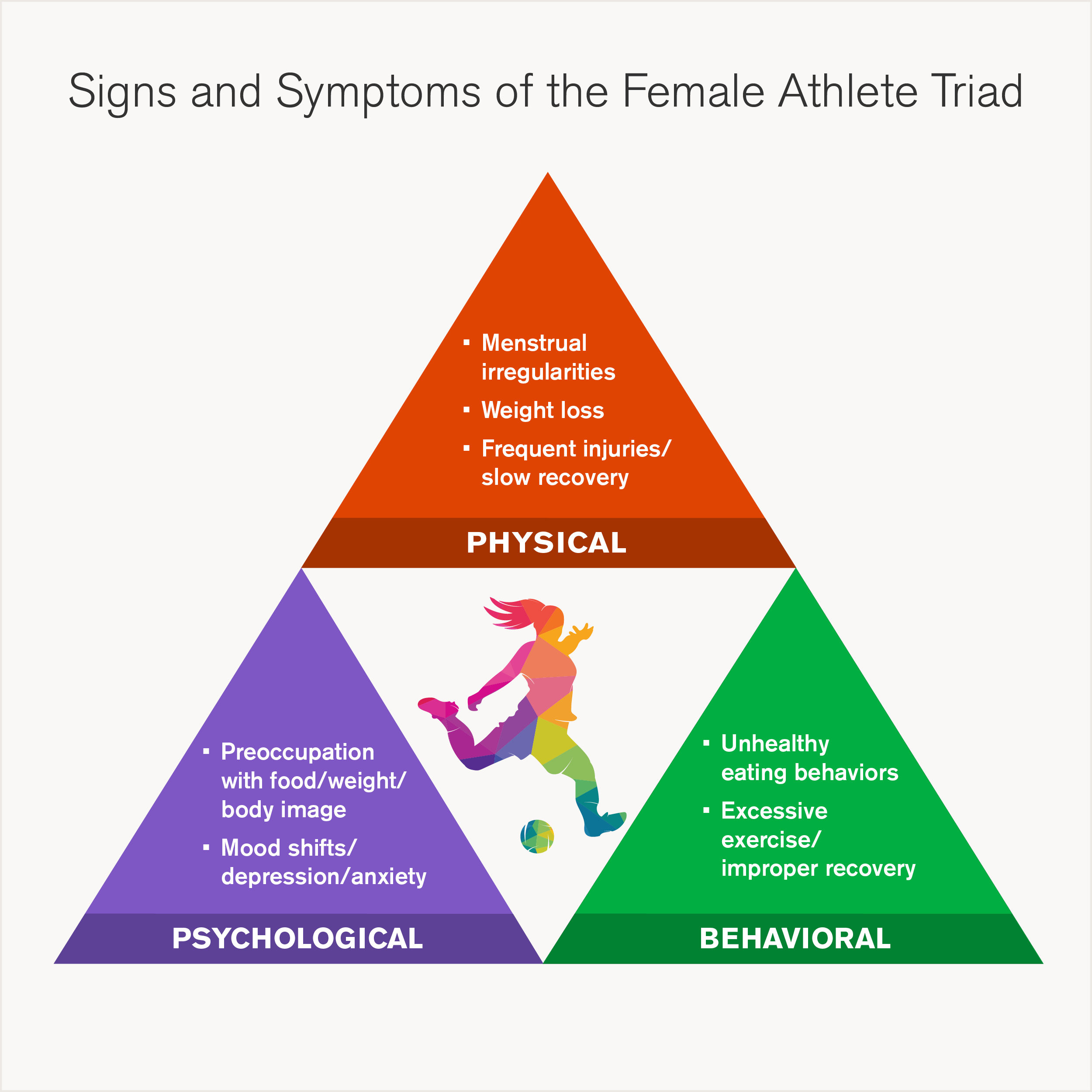What is the Female Athlete Triad? A Comprehensive Guide for Athletes and Coaches
March 13, 2024
Categories: Women's Health, Sports Medicine, Orthopaedics
 By Stacey Bennis, MD, Orthopaedic Sports Medicine
By Stacey Bennis, MD, Orthopaedic Sports Medicine
In the world of competitive sports and physical fitness, the pursuit of excellence often pushes athletes to their limits. Among female athletes, this pursuit, coupled with societal pressures, can sometimes lead to a complex health disorder known as the Female Athlete Triad. This syndrome has significant health risks regarding the well-being and performance of women in sports.
We spoke with Stacey Bennis, MD, CAQ-SM a sports medicine physician at Loyola Medicine, to learn more about the Female Athlete Triad, including symptoms, prevention and management.
"The Triad can happen in any type of sport or any type of athlete. Girls or women who are not getting enough nutrition into their bodies to meet the demand they're putting into their sports start to experience negative physical symptoms," says Dr. Bennis.
What is the Female Athlete Triad?
The Female Athlete Triad is a medical condition that primarily affects physically active females. It's a syndrome that occurs when an athlete's energy intake (i.e., calories “in” through food or drink) is less than their expenditure (i.e., calories “out” through exercise). There are three main components to the syndrome: energy availability (nutrition), menstrual health (periods), and bone health.
Energy availability
Energy availability refers to the amount of energy remaining for the body's functions after subtracting the energy expended during exercise from the total energy intake through food. When energy availability is low, the body doesn't have enough fuel to support the functions necessary for good health, such as maintaining normal reproductive and bone health. Low energy availability can be intentional, resulting from disordered eating behaviors, or unintentional, stemming from a lack of awareness about nutritional needs.
Menstrual health
Female athletes can also experience disruptions in their menstrual health. In its most severe form, also known as amenorrhea, menstrual periods can be absent for three months or more. These disruptions occur because the body, in an energy-saving mode, downregulates the hormonal pathways responsible for menstruation. Regular menstrual function is crucial not just for fertility but as a key indicator of overall health, particularly adequate energy availability, hormonal balance and bone health.
Bone health
The final component of the Triad is bone health. Estrogen, a hormone whose production is affected by low energy availability, can impair menstrual health and bone health. Estrogen plays a vital role in bone growth and maintenance. When estrogen levels are low, bone density can decrease, leading to osteopenia or osteoporosis. This reduction in bone density increases the risk of stress fractures and other bone injuries, which can have immediate and long-term implications for an athlete's health and career.
It's important to recognize that the Female Athlete Triad exists on a spectrum. Athletes can experience varying degrees of low energy availability, menstrual dysfunction, and bone health issues. This means that not all athletes will exhibit all three components of the Triad to the same extent. Some may have mild menstrual irregularities and normal bone density, while others may experience significant menstrual disruptions and severe bone health issues.
What are the causes and risk factors for the Female Athlete Triad?
The Female Athlete Triad is caused by an imbalance between energy intake and energy expenditure. This imbalance can result from not consuming enough calories to meet the demands of physical activity or excessively exercising beyond what the body's energy reserves can support.
"There are sports that can contribute more to the triad than others. For women it's the runners, gymnasts, dancers, the sports that tend to value a leaner physique. Unfortunately, it's any sport where either there's a pressure to have a certain weight or in some instances the athletes are just so passionate that they tend to sometimes overdo it," says Dr. Bennis.
Risk factors for the Female Athlete Triad include individual, sports-related, and societal factors, each contributing to the condition's complexity.
While certain factors increase your risk, protective factors can mitigate these risks. These include a supportive environment that emphasizes health and well-being over appearance, access to accurate information about nutrition and exercise, and a positive coaching culture that prioritizes the athlete's long-term health.
What are the signs and symptoms of the Female Athlete Triad?
Symptoms of the Female Athlete Triad can vary widely among individuals. Recognizing these signs early is crucial for timely intervention and prevention of severe health consequences. Symptoms can appear physically, psychologically and even behaviorally.
One of the first signs of the Triad is menstrual dysfunction which usually manifests as delayed or skipped periods. If a female athlete hasn't had her first period by 15 or has irregular or missed periods, they should seek care from a sports medicine physician.
"Regardless of what sport or exercise someone competes in, the symptoms are going to be fairly similar. What will change is the severity of the various symptoms, which will depend on the individual," says Dr. Bennis.

Awareness and vigilance by coaches, parents, and teammates play a critical role in identifying the signs and symptoms of the Triad early. Encouraging open dialogue about health, nutrition, and body image within the sporting environment can help create a supportive atmosphere for addressing these issues.
Prevention and management of the Female Athlete Triad
Prevention and management require a proactive, multidisciplinary approach that addresses the physical, psychological and environmental aspects of the syndrome. Effective strategies involve athletes, coaches, parents, and health care providers working together to create a supportive environment that prioritizes health, well-being, and sustainable athletic performance.
Loyola Medicine's women's sports medicine program provides comprehensive care for the individualized needs of female athletes.
"Treatment will depend on the severity of the syndrome. If somebody is at a very mild, early stage where we're catching it early then we can just talk through their risks in the office, and quick adjustments to their lifestyle may be all that's needed," says Dr. Bennis.
"However, if somebody is coming in and they truly have an eating disorder such as anorexia or bulimia, or they have severe symptoms of the Triad then sometimes we have to actually have them take a break from their sport until they're well managed and feeling better."
Prevention involves early education, promoting healthy behaviors, and fostering a supportive athletic environment. Some key strategies are:
Educating athletes, coaches, and parents, including signs, symptoms, and long-term consequences, is crucial. Awareness programs should cover topics such as nutritional needs, the importance of regular menstrual cycles, and the risks associated with low energy availability.
Cultivating an athletic environment that values health and well-being over performance alone can significantly reduce the pressure on athletes to engage in harmful behaviors. Coaches and sports organizations should emphasize goal setting that focuses on effort, improvement, and personal bests rather than weight, appearance, or winning at all costs.
Providing access to sports dietitians or nutritionists who can offer personalized eating plans that meet the energy demands of training and competition is essential. Nutritional education should emphasize the importance of balanced diets that support optimal health and performance.
Regular health evaluations, including assessments of menstrual function, nutritional status, and bone health, can help identify early signs of the Triad.
If the Female Athlete Triad is diagnosed in a patient, a comprehensive management plan should be implemented, tailored to the individual's specific needs. This plan may involve:
Addressing any medical concerns, such as menstrual irregularities or bone health issues, may require collaboration with healthcare professionals, including physicians, endocrinologists, and gynecologists. Treatment may involve nutritional interventions, supplements, or medications to address specific deficiencies or conditions.
Restoring energy balance is a priority. This may involve working with a dietitian to increase energy intake, adjust eating patterns, and ensure that dietary needs are met to support recovery and health.
Mental health professionals can play a critical role in addressing underlying psychological factors, such as body image concerns, stress management, and coping strategies. Counseling or therapy may be beneficial for athletes struggling with disordered eating behaviors or those who need support in adjusting their approach to training and competition.
Reducing exercise intensity or volume, and incorporating rest periods can help restore energy balance and support recovery. Coaches and trainers should work closely with healthcare providers to ensure that training programs are aligned with the athlete's health status and recovery goals.
By fostering an environment that promotes health, well-being, and informed decision-making, it is possible to protect athletes from the triad's adverse effects. Through education, supportive practices, and a commitment to athlete health, the sports community can help ensure that female athletes achieve their potential in a way that is both healthy and sustainable.
Stacey Bennis, MD, CAQ-SM is a Sports Medicine physician at Loyola Medicine. Taking care of the whole spectrum of athletes, from high school to adulthood, Dr. Bennis helps treat everyone, including weekend warriors and professional athletes. Dr. Bennis is also dual-appointed in the Department of Obstetrics and Gynecology, taking care of women with pelvic pain and pregnancy/postpartum pain symptoms.
Book an appointment today to see Dr. Bennis or another of Loyola Medicine's specialists by self-scheduling an in-person or virtual appointment using myLoyola.
